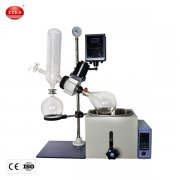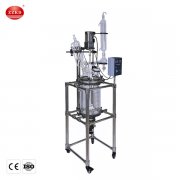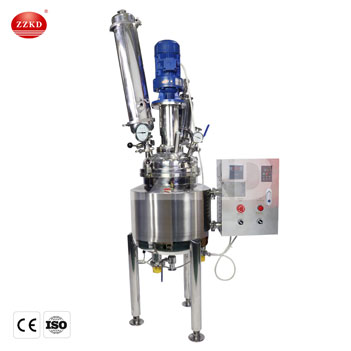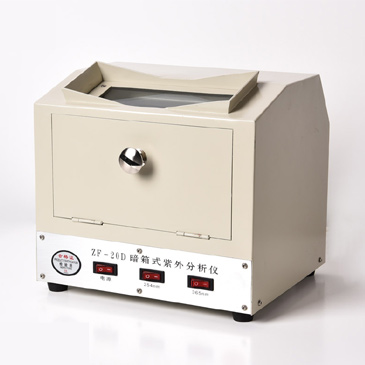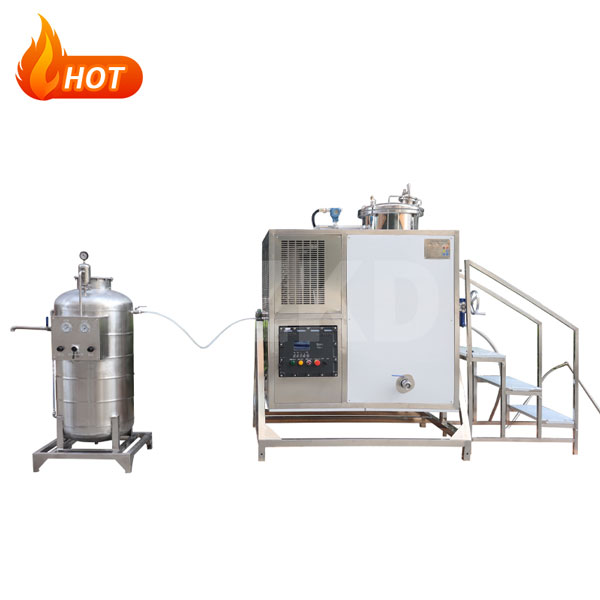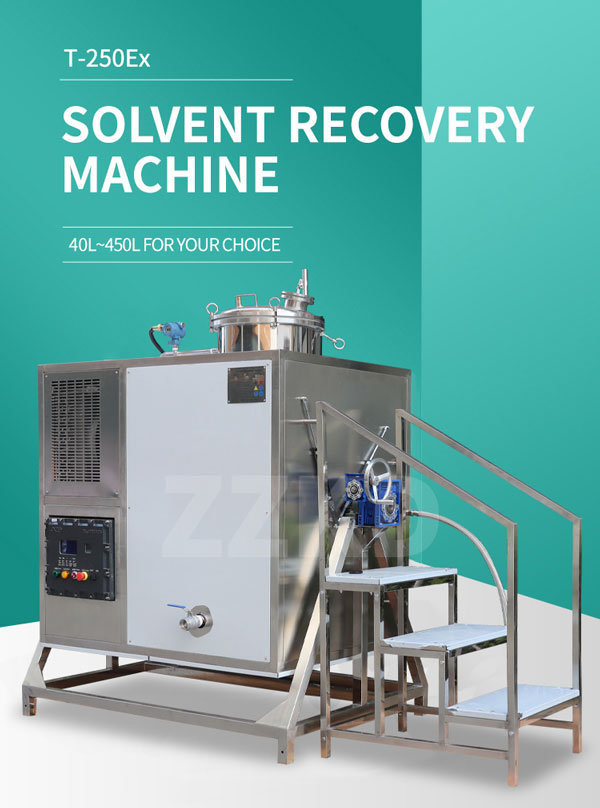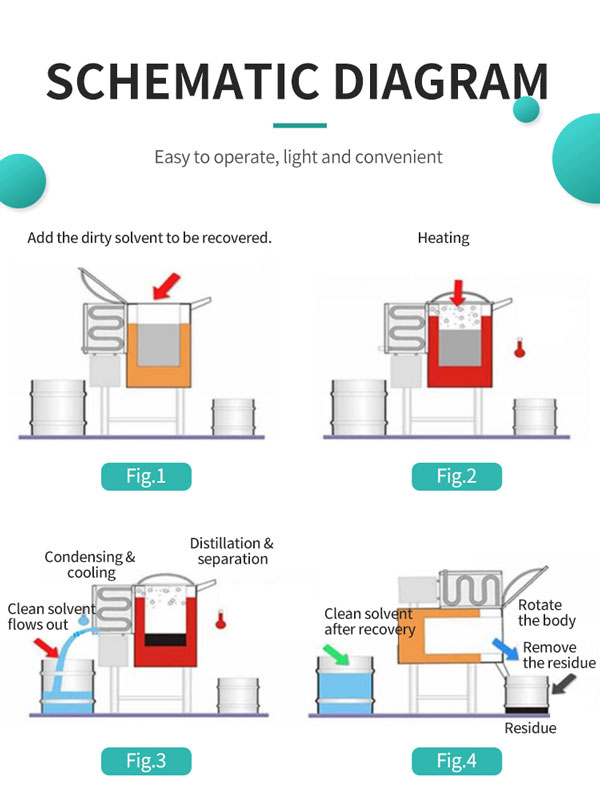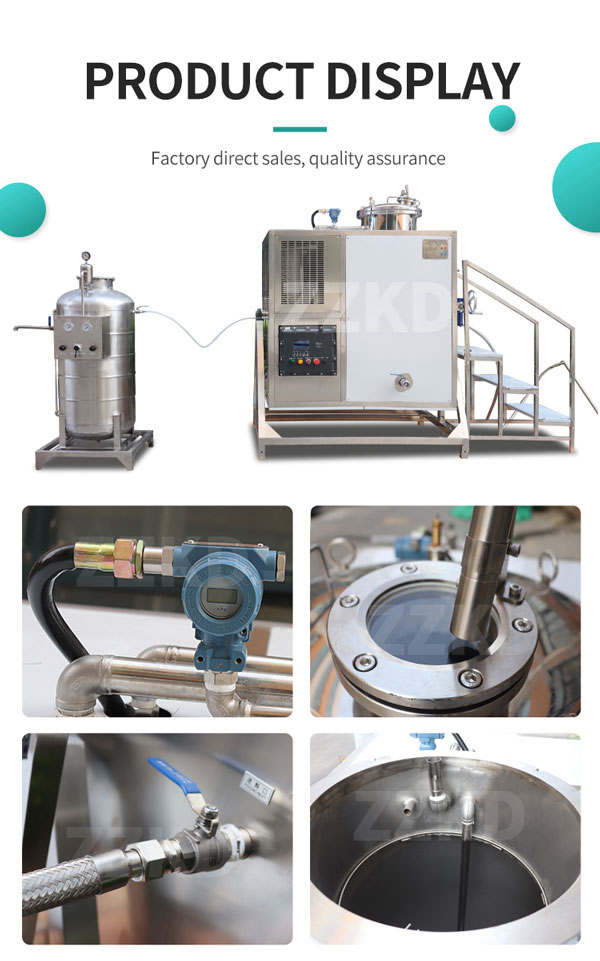Ethanol recovery equipment plays a vital role in reducing waste and increasing efficiency in industries that use ethanol. Benefits of ethanol recovery equipment include reduced waste and disposal costs, reduced environmental impact, and the ability to recover ethanol from a variety of sources. As the demand for ethanol continues to increase, the importance of ethanol recovery equipment will only continue to grow.
Working Principle Of Ethanol Recycling Equipment:
A solvent recovery machine typically consists of three main parts: the condenser, collection vessel, and heating element. An alcohol-based liquid or gas mixture is introduced into the machine and the heating element is activated to increase the temperature of the mixture. As the temperature rises, the alcohol evaporates and is sent through the machine's pipes to the condenser, where it is cooled and converted back to a liquid state. The recovered alcohol is then collected in a container while any remaining liquid or gas is vented from the machine.
Ethanol Recycling Equipment Recycling Alcohol
Ethanol recovery from a solution reclaimer is a process that involves separating ethanol from water in a solution reclaimer. Ethanol is a clear, colorless liquid commonly used as a solvent, fuel, and disinfectant. It is also used in the production of various products such as cosmetics, pharmaceuticals and food. Ethanol recovery is a critical process that helps ensure that the maximum amount of ethanol is extracted from the ethanol recycling equipment while minimizing waste and increasing efficiency.
Ethanol recycling equipments are an essential part of many industries that use solvents in their production processes. It is a machine designed to separate a solvent from the substances it dissolves. During ethanol recovery, a ethanol recycling equipment is used to separate ethanol from water. The recycling process involves several steps designed to maximize efficiency and minimize waste.
1. Add the solution to be treated in the container
The first step in the ethanol recovery process is to transfer the solution containing ethanol and water to a ethanol recycling equipment. The machine separates ethanol from water using various methods, including distillation, evaporation and condensation. The choice of method depends on several factors, including the concentration of ethanol in the solution, the volume of the solution, and the efficiency of the machine.
2. The heating rod heats the heat medium oil in the interlayer of the recovery barrel.
Distillation, a common method of ethanol recovery, involves heating a solution to a temperature that causes the ethanol to evaporate. The vapor is then condensed back into a liquid, collected and stored. The remaining mostly aqueous solution was discarded. Distillation is an efficient method of ethanol recovery and can achieve high purity. However, it is also an energy-intensive process, requiring a lot of heat and electricity.
3. The heat medium oil transfers heat to the waste solution in the recovery barrel to heat up the solution, and the organic solvent changes from liquid to gas after being heated.
Evaporation is another method of recovering ethanol that involves heating the solution to a temperature that causes the water to evaporate. The vapor is then condensed back into a liquid, collected and stored. The remaining solution, mainly ethanol, is also collected and stored. Evaporation is a less energy-intensive process than distillation and is typically used for smaller volumes of solutions.
4.The gaseous solvent is liquefied and flows out through the cooling system; the separated clean solvent flows into the recovery vessel.
Condensation is a method of recovering ethanol that involves cooling the solution to a temperature at which the ethanol condenses into a liquid. The fluid is then collected and stored. The remaining mostly aqueous solution was discarded. Condensation is a less energy-intensive process than distillation, but is generally less efficient at achieving high levels of purity.
5. Clean up the residue after the heat medium oil is cooled.
Best Practices for Using a ethanol recycling equipment
1.Choose the Right Machine for Your Industry and Application:
Different industries have different requirements, and it is essential to choose a ethanol recycling equipment that is designed for your specific application. This will ensure that you get the best performance and the most cost-effective solution for your business.
2.Regular Maintenance:
Regular maintenance is essential for keeping your ethanol recycling equipment running efficiently. This includes cleaning the machine, replacing worn parts, and checking for leaks or other issues. Regular maintenance can also help prevent downtime and extend the lifespan of your equipment.
3.Proper Training:
Proper training is crucial for operating a ethanol recycling equipment safely and effectively. Make sure that all operators are trained on the specific machine they will be using and that they understand the proper procedures for loading and unloading solvents.
4.Use High-Quality Solvents:
Using high-quality solvents can help improve the performance and lifespan of your ethanol recycling equipment. Low-quality solvents can contain impurities that can damage the machine and decrease its effectiveness.
5.Monitor Solvent Quality:
It is important to monitor the quality of recovered solvents to ensure that they are suitable for reuse. This includes checking for impurities, acidity, and other factors that can affect the quality of the solvent.
6.Proper Disposal of Contaminants:
Contaminants that are removed from the solvent during the recovery process must be disposed of properly. This may include recycling or disposing of the contaminants according to local regulations.
7.Regularly Review and Improve Processes:
Regularly reviewing and improving your recovery processes can help you optimize the performance of your ethanol recycling equipment. This may include identifying areas where waste can be reduced, improving the efficiency of the recovery process, or finding ways to reuse recovered solvents more effectively.

 Products
Products





